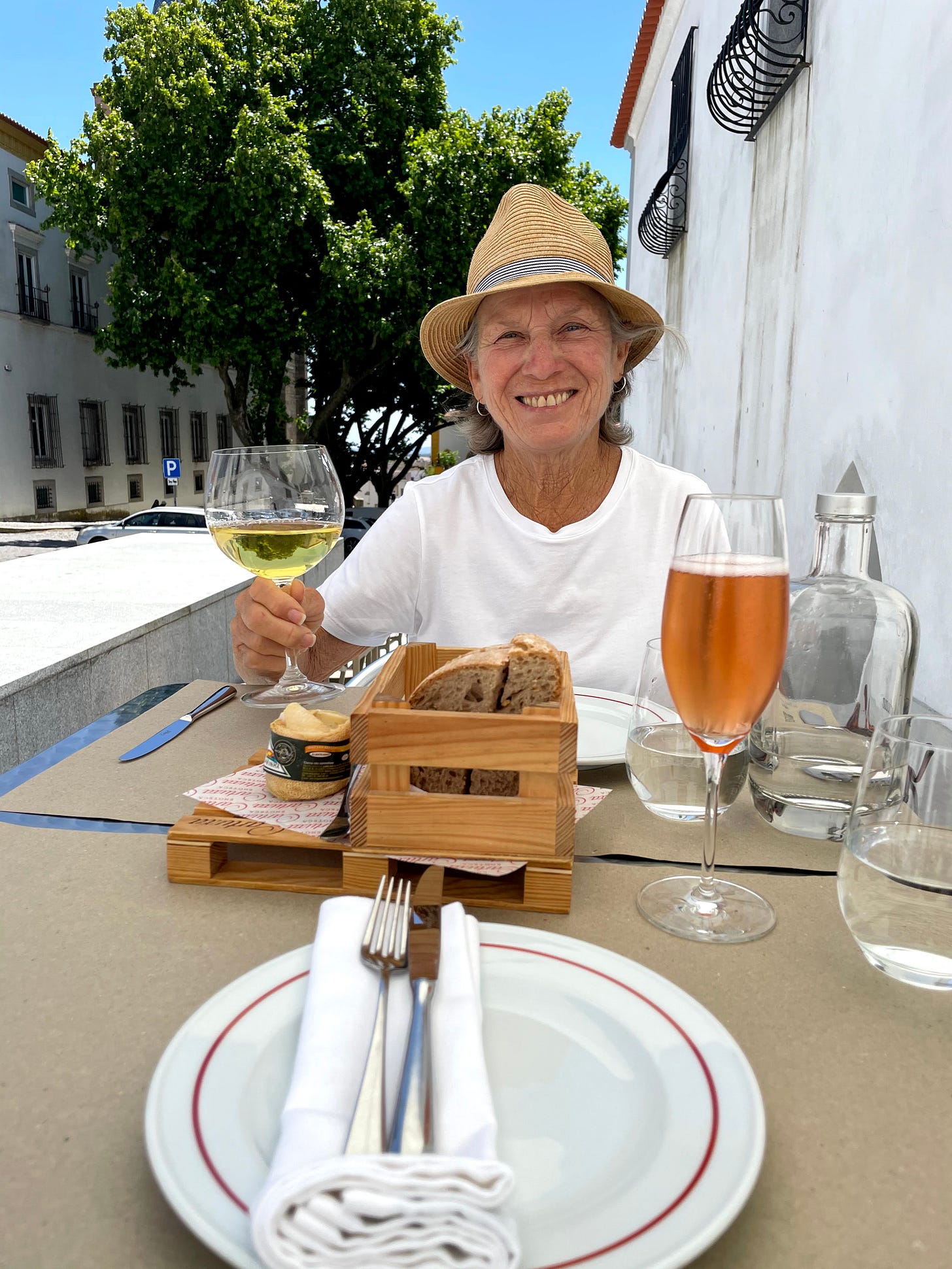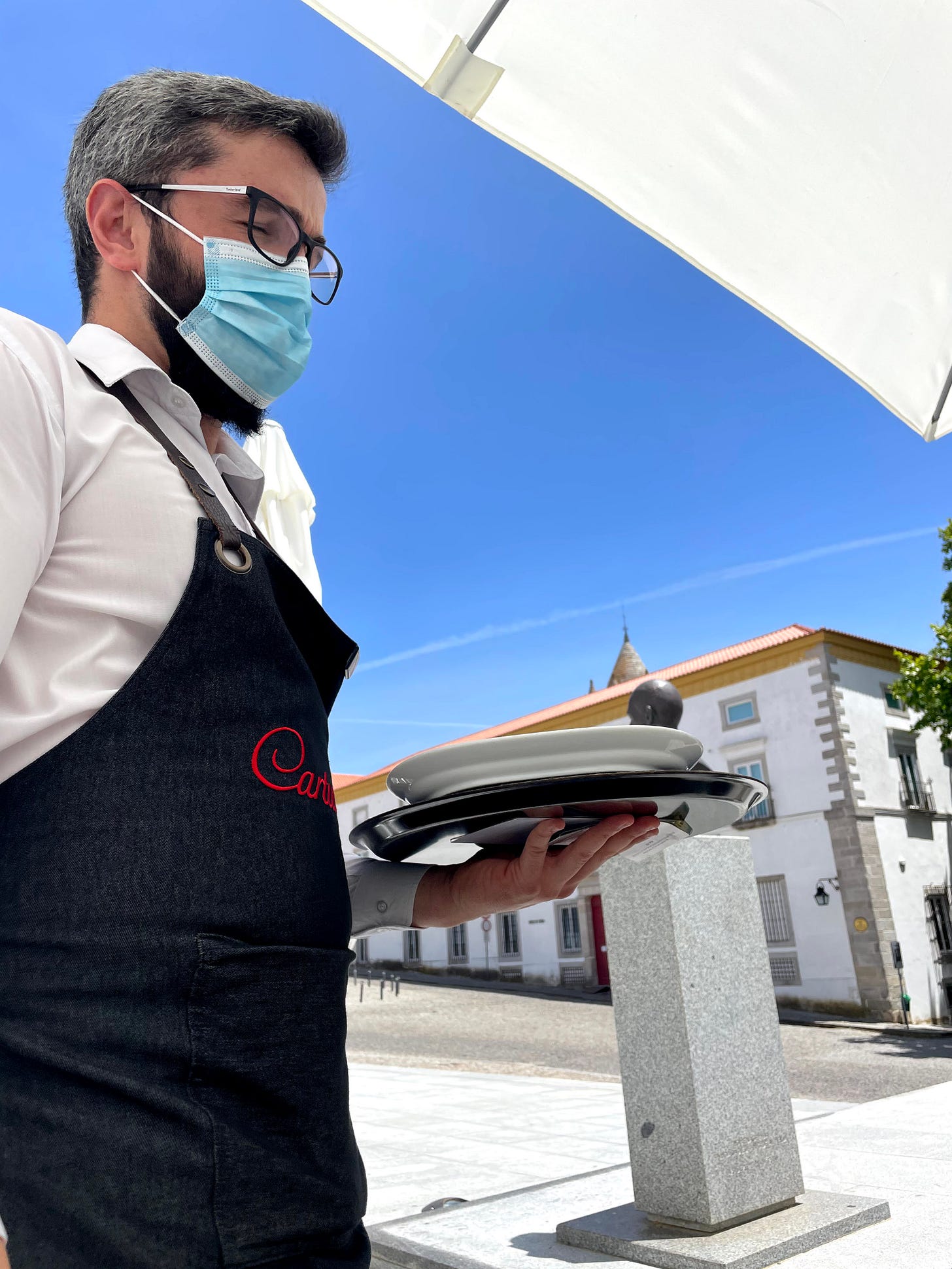As I mentioned in the prior post, the hotel receptionist recommended three restaurants. Our walking tour guide, Sandra, recommended only one. As it was also on the top of the list of three we went to Enoteca Cartuxa.
One Rich Guy
The history of this place dates back to 1913, the year Vasco Maria Eugénio de Almeida was born to a powerful and wealthy family. He studied agronomy but devoted his life to philanthropic works, most of it in Évora and the surrounding area. His patronage rebuilt a convent, supported the Évora College, built a hospital and public parks. After his death in 1975, the foundation he started (Fundação Eugenio de Almeida) looked for ways to:
… guarantee the economic self-sustainability of the Institution and the pursuit of its purposes, also contributing to the promotion of the economic and social development of the region. — Foundation Website
Among the most successful ventures were viticulture (Cartuxa Winery) and olive growing (Cartuxa Lagar). These are complemented by the restaurant where we had lunch.

Cartuxa Winery
Our guide Sandra had mentioned Cartuxa Winery during our tour. Specifically, she mentioned the Pêra-Manca red which while pricey is considered among the best reds in the world. The Cartuxa Winery at Quinta de Vaibom is just a 7-minute drive or 30-minute walk from the center of town. (Note to Angie: we think this should be part of our Évora trip with you and John this September. My apologies to readers that are not related to us, but I had to take care of some family business.)
Anyway, the connection between today’s Foundation and the winery goes back many years. It seems the Jesuits were in this area in the mid-1500s and are responsible for the creation of what is now the Évora College. They also bought the Quinta (farm) which is today the winery. The Jesuits were expelled from Portugal in 1759 and the property was turned over to the State which started producing wine. The great-grandfather of Vasco Maria bought the Estate in 1869. It was inherited by his grandfather Carlos Maria Eugenio de Almeida, who immersed himself in expanding agricultural production. Expansion and modernization continued and the facility is now responsible for the production of 4 million bottles per year (These are red, rose and white wines of brands, Vinea, EA, Foral de Évora, Cartuxa, Scala Coeli, and Pêra-Manca.)
Back to Lunch
As the Pêro-Mancha red is only sold by the bottle (a real steal at only 290€ at the restaurant) Denise opted for their white. I chose a Cartuxa sparkling rose. Both are expensive by Portuguese standards at 11€ and 7,50€ a glass. The fact that we left lunch having purchased 3 bottles of each to take home should convince you that we liked them a lot!
As for lunch, we began our meal with bread and cheese. Specifically, Queijo da Ovelha, a soft yellow-white cheese that is served in its rind. Warmed for just a bit, the top of the rind removed, it can be spread on the brown bread that accompanied it. (Note: just in case you don’t know…if you don’t plan to eat the bread, or olives, or other things put on the table when you are seated ask for them to be removed. These are not complimentary!) We opted for three small plates, starting with mushroom and zucchini in olive oil, garlic, and rosemary. Even though we shared this dish we ended up bringing half of it home. It was wonderful, but filling, and we wanted to have room for what was served next. Denise opted for pork cheeks, a regional specialty and I ordered the shrimp in garlic. Denise reported that the pork cheeks were tender and juicy. And Daniel explained that after cooking, the chef removes much of the fat…for the health-conscious eater. As for my dish, let me just say you can’t go wrong with great olive oil and lots of garlic…and my shrimp were cooked to perfection!
Daniel
One of the things we love about Portugal is the pace of life. I have written about this before. Though the Portuguese may seem quiet and aloof at first if you introduce yourself or ask a question they instantly become talkative and engaging. Daniel, our server, seemed to have all the time in the world to educate us on wine and food. He also was willing to answer any question, even my totally non-food-related questions: “Were you born and raised here? Do you still notice the castles and cathedrals as you walk by them every day?”
Yes, Daniel was born in Évora. No, he never wanted to live anywhere else. Yes, he still was in wonder when he walked by the wall, the palaces, the cathedrals. He loved the pace of life…the fact that it gave him time to notice something new every day.
Shouldn’t we all feel that way about where we live?
Reader Survey Feedback: I wanted to provide one more result from the reader survey. It appears many readers like the variety of topics covered:
In fact, while a few readers commented that I should keep my political opinions to myself, most commented that they liked the way I mixed things up. As to requests, many people wrote they wanted more on food. So, like today, I will try to do that. (I, however, cannot promise that you will ever see the plates before we eat.)
One final note, for my former RVPicklers readers, Denise has not played pickleball in Portugal. She has heard about one facility in Marfa…but that is not nearby. She did take a padel lesson in part hoping to hook the pro on pickleball. There are some pickleball skills that are transferrable to padel, but hitting off the wall or out the doorway is an entirely new skill.
Also, unlike the States, all the tennis courts are owned by a club and are clay. One does not find public hard tennis courts in parks. So for right now, we are focusing on golf.








Your posts make me very hungry, lol! Thanks for taking the time to share your lives
I don’t like olives but I know I can find a lot of things I do love, like bread and cheese.l 😋.